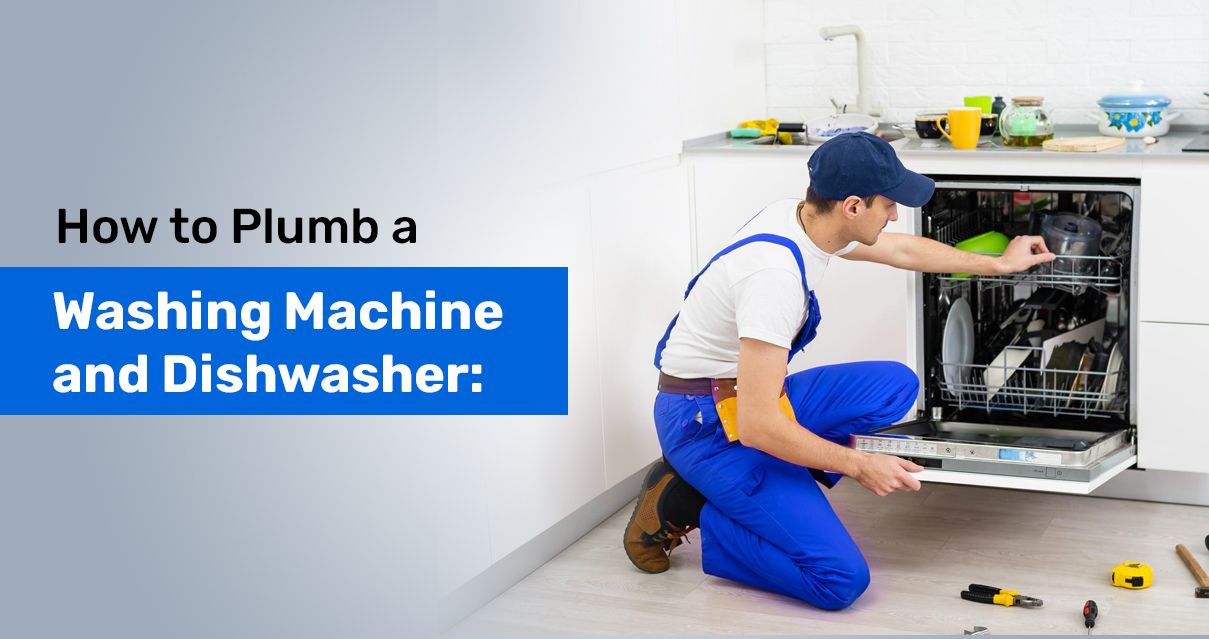Efficiently plumbing a washing machine and dishwasher is a fundamental aspect of ensuring the seamless operation of these essential household appliances. At FixDar, we understand the importance of proper installation, which is why we’ve crafted this comprehensive guide to help you navigate the process effortlessly. From gathering the necessary tools to optimizing the location and connections, this step-by-step guide will empower you to plumb the washing machine with confidence. Let’s dive into the details of each stage, ensuring a hassle-free installation that guarantees optimal performance.
Steps To Plumb Washing Machine and Dishwasher:

Step 1: Assemble Your Tools and Materials:
To embark on a successful plumbing journey, gather all the required tools and materials beforehand. For a standard washing machine and dishwasher installation, you’ll likely need a wrench, screwdriver, adjustable pliers, Teflon tape, and manufacturer-provided hoses and connectors. Ensuring you have the right tools at your disposal is the first step towards a smooth plumbing process.
Step 2: Choose the Optimal Location:
Selecting the right location is paramount for the successful plumb washing machine and dishwasher. Opt for a level and well-ventilated area, ensuring proximity to the necessary water and drainage connections. At FixDar, we recommend positioning the appliances near existing plumbing lines to simplify the installation process.
Step 3: Locate Water Supply and Drainage Points:
Identify the water supply and drainage points in the chosen location. Plumb washing machine and dishwashers require access to both hot and cold water lines, as well as a suitable drainage point. Make sure these connections are easily accessible and adhere to the specifications outlined in the appliance manuals.
Step 4: Install Water Supply Lines:
Connect the water supply lines to the designated hot and cold water valves. Use Teflon tape on the threads to guarantee a secure and leak-free connection. Utilize an adjustable wrench to tighten the connections, ensuring they are secure without overtightening.
Step 5: Connect the Drain Hose:
Attach the drain hose to the designated drainage point, ensuring a secure and reliable fit. The drain hose should be positioned with a loop or secured in a way that prevents water from siphoning back into the machine. If necessary, use hose clamps to secure the connection and avoid potential leaks.
Step 6: Secure the Appliances in Place:
Once the water supply and drainage connections are established, position to plumb washing machine and dishwasher in their designated spots. Adjust the leveling feet to guarantee stability and balance. Securing the appliances in place is crucial to prevent unnecessary movement during operation, minimizing the risk of leaks or damage.
Step 7: Power Connection for Dishwashers:
For dishwasher installations, ensure a power source is readily available. Most dishwashers require a standard electrical outlet. If there’s no existing outlet, consult with an electrician to install one, ensuring compliance with safety standards and regulations.
Step 8: Test Run and Check for Leaks:
Before running a full load, perform a test run to identify any leaks or irregularities in the water supply and drainage connections. Monitor the appliances during the cycle and inspect for water accumulation around the base. Address any issues promptly to prevent potential water damage and ensure the longevity of your appliances.
Tips for a Seamless Installation of Washing Machine and Dishwasher:
There are some excellent tips for easy installation of appliances;
Review Appliance Manuals:
Familiarize yourself with the manufacturer’s guidelines provided in the appliance manuals. Each model may have specific requirements and recommendations for installation.
Invest in Quality Hoses and Connectors:
Prioritize high-quality hoses and connectors to ensure durability and prevent leaks. Choosing cheap or worn-out components can lead to water damage and operational issues.
Consider Water Hammer Arrestors:
Install water hammer arrestors on the water supply lines to minimize vibrations and pressure surges, enhancing the longevity of your appliances and plumbing system.
Apply Thread Sealant:
Use thread sealant or Teflon tape on threaded connections to create a watertight seal and prevent leaks, ensuring the longevity of your plumbing system.
Conclusion:
Efficient plumbing is paramount for the optimal performance of plumb washing machine and dishwashers, and with FixDar’s guide, you can navigate the installation process confidently. Follow the outlined steps, implement the provided tips, and experience the convenience of a well-plumbed laundry and kitchen. For expert assistance and reliable Plumbing Services In Karachi to plumb washing machines and dishwashers, trust FixDar to keep your home running efficiently and your appliances in top-notch condition.



